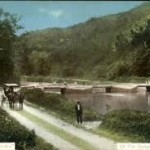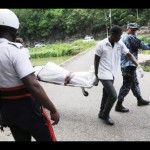For decades, fatal accidents in the Bog Walk gorge, particularly around the Flat Bridge, have made the headlines as the area developed a reputation as a black spot.
The Rio Cobre, which runs beneath the more than 300-year-old bridge, has been the scene of some of the most horrifying motor vehicle accidents in the nation’s history, with some bodies never recovered from the murky water.
The latest fatal crash to have occurred at the bridge took place eight days ago, when the driver of a Suzuki Vitara lost control of the vehicle, which ran off the road and into the river, leaving six of its eight occupants dead.
This has again sparked debate on what can be done to reduce the number of fatal accidents in the area.
Guard rails, the widening of the bridge, stationary police teams in the area or speed bumps on the approaches to the bridge are among the many suggestions over the years. However, not much has been done to make the crossing safer and many believe there is no need for physical changes.

Despite the numerous crashes in the vicinity of the bridge, head of the Police Traffic Division, Senior Superintendent Calvin Allen, said the statistics do not suggest that Flat Bridge is more accident-prone than many other places across the island.
“In 15 years, we have had 12 fatalities (including the latest six) in the vicinity of the Flat Bridge. However, in that same 15-year span we have had 32 collisions that resulted in 46 deaths along the Bog Walk gorge,” Allen said.
“The Flat Bridge in itself is quite OK. Persons just need to negotiate the area using their skill and experience from the perspective of how they were taught to drive to negotiate the Flat Bridge.”
The dangers of the bridge have also caught the attention of Prime Minister Andrew Holness who, last week, told our news team that it has entered his policy zone.

“There has been a massive investment in the North-South Highway which creates an alternative route, but that is a paid route.
“So the Flat Bridge will have to be given consideration, and it is now something in my zone of contemplation to make it safer,” said Holness.
He noted that the Bog Walk gorge carries a high volume of traffic and a very low percentage of accidents.
“The accidents that happen there are persons who are definitely speeding, and who are driving recklessly and carelessly. So it is a matter of public consciousness and public awareness.
“There is some amount of design work that I believe can be done to reduce the speed in the gorge and approaching Flat Bridge. So there could be greater signage, there could be speed bumps along the way; in other words, there are things that can be done to increase the safety and ensure that drivers obey the rules,” added Holness.

Executive director of the National Road Safety Council, Paula Fletcher, agreed that most of the crashes in the vicinity of the bridge resulted from bad choices by drivers.
According to Fletcher, the statistics show that in more than 90 per cent of crashes persons were speeding, drinking and driving, not wearing a seat belt, or overtaking recklessly.
But despite the statistics, Fletcher is urging the authorities to protect people from themselves where the Flat Bridge is concerned, as drivers are prone to making bad choices on the road.
“Our approach at the National Road Safety Council is not what everybody else would say: that there is nothing wrong with the bridge,” said Fletcher.
“Our approach would be to use the safe-systems approach to do all and everything we can to keep vehicles on the bridge. So we would have to do a road-safety audit of that bridge. I think we need to do more because six people drowning at one time is just too much.

“Some engineering method has to be found to keep cars from going over there. I think some sort of physical thing is needed, even if it gets destroyed over time with water. I think it is really incumbent on us to preserve lives,” added Fletcher.
That suggestion has been taken on and communication and customer services manager at the National Works Agency, Stephen Shaw, told our news team that engineers are exploring various options to see what can be done to improve safety on the bridge.
“They (engineers) have been given the charge to come up with some plans that will be discussed internally with a view to settling on an approach going forward,” said Shaw.
“Among these would be the erection of jersey barriers. We are also looking at the possibility of putting a cable barrier system, something akin to that which is along Palisadoes strip.

“The engineers are going through and doing their design. Once we have done that, the discussions will continue. We will then be in a position to come up with some costing. Budget would have to be looked at (as we are) not sure where the funding is coming from.”
According to Shaw, while there is no thought being given to widening the bridge, the agency is looking to do some work in terms of markings along the road network, while the gorge will also benefit from an extensive road-marking project slated to come on stream.
“In terms of the issue of signage, markings, cat’s eyes … those are also things that we are looking at,” said Shaw.
“We have gone to tender for road markings to be done, so we are about to make an award for more than 100 kilometres of markings to be done on roads across the island, and I’m sure the gorge will benefit from this particular program.”

In the meantime, former head of the Jamaica Constabulary Force’s Road Traffic Division, Radcliffe Lewis, is calling for constant police presence in the vicinity of the bridge to dissuade persons from driving recklessly.
“My recommendation is that a police unit be assigned there permanently, just like Barbican Road where there is a unit to control crime and violence,” said Lewis.
But going back to his statistics, the man who now heads the police traffic division argued that it would be a waste of resources to have a static police presence at the Flat Bridge.
“We have lost more lives along the Bog Walk gorge than what we have lost at Flat Bridge itself and so whatever resources we have, we have to make it man-oeuvre the entire strip,” said Allen.
“We are talking about a spot where there is signalized traffic light, so that would be a waste of government resources to just put a police vehicle there right throughout the day.”


